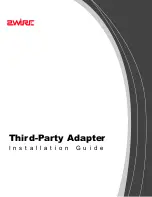
No operations are active. The
Installed version
field displays all currently installed product versions.
(Empty field)
3.
When all required version numbers are selected, click
Start
.
The
Installation editor
launches the
Installation wizard
, which queries the user for the installation
parameters. The
Installation editor
then prepares a distribution installation package that is customized
for the specific installation operation. The new package is saved on Policy Manager Server.
Note:
The
Start
button is used to start the installation operations selected in the
Version to install
field. If the
Installation editor
is closed without first clicking the
Start
button, then all changes will be
discarded.
4.
Because the installation operation uses policy-based triggering, you must distribute new policy files.
The policy file will contain an entry that tells the host to fetch the installation package and perform the
installation.
Note that it may take a considerable length of time to carry out an installation operation. This may happen
if an affected host is not currently connected to the network, or if the active installation operation requires
a user to restart his host before the installation is completed. If the hosts are connected to the network
and they send and receive policy files correctly, then there could be a real problem. The host may not be
correctly acknowledging the installation operation. In any case, it is possible to remove the installation
operation from the policy by clicking
Stop all
. This will cancel the installation operations defined for the
selected policy domain or host. It is possible to stop all installation tasks in the selected domain and all
subdomains by selecting the
Recursively cancel installation for subdomains and hosts
option in the
confirmation dialog.
The
Stop all
button is enabled only if the current host or domain has an installation operation defined.
Any subdomain operations do not affect the button state.
Stop all
only removes the operation from the
policy. If a host has already polled the previous policy file, it may try to carry out the installation operation
even though it is no longer visible in the
Installation editor
.
Remote uninstallation:
Uninstallation can be performed as easily as an update. A distribution package is created that contains only
the software needed to uninstall the product. If the product does not support remote uninstallation, the
Installation editor
does not display an option for uninstallation.
Choosing
Reinstall
will reinstall the current version. This option should only be used for troubleshooting.
Most of the time, there is no reason to reinstall a product.
When uninstalling Management Agent, no statistical information will be sent stating that the uninstallation
was successful, because Management Agent has been removed and is unable to send any information. For
example, if uninstalling F-Secure Anti-Virus and Management Agent:
1.
Uninstall F-Secure Anti-Virus
2.
Wait for Policy Manager Console to report the success or failure of the uninstallation.
3.
If F-Secure Anti-Virus was uninstalled successfully, uninstall Management Agent.
4.
If uninstallation of Management Agent is unsuccessful, Policy Manager Console will display a statistical
report of the failure. Success cannot be reported, but is evident from ceased communication, and the final
report for Management Agent will state
in progress…
.
Local installation and updates with pre-configured packages
You can export pre-configured packages in JAR or in MSI (Microsoft Installer) format.
The MSI packages can be distributed, for example, using Windows Group Policy in an Active Directory
environment.
46
| F-Secure Policy Manager | Using Policy Manager Console
Содержание POLICY MANAGER 9.0
Страница 1: ...F Secure Policy Manager Administrator s Guide ...
Страница 2: ......
Страница 6: ...6 F Secure Policy Manager TOC ...
Страница 28: ......
Страница 66: ......
Страница 90: ......
Страница 94: ......
Страница 98: ......
Страница 102: ......
















































